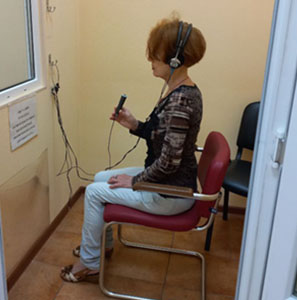What Does a Hearing Audiometry Test Show?
The Principle of Audiometry and What It Measures
Audiometry of hearing is a modern examination method that allows determining the level of perception of sounds of different frequencies and intensities. The procedure involves delivering sound signals through headphones and recording the patient’s response. This approach ensures accurate measurement of hearing and can detect even minor deviations.
During audiometry, a specialist uses special devices called audiometers, which generate sounds across a range of low to high frequencies. The patient indicates when they hear the sound, allowing the minimum levels of perception for each frequency to be recorded.
Audiometry also helps evaluate the uniformity of hearing in both ears. By comparing the results, the doctor can identify differences between the left and right ear, which is important for diagnosing specific disorders.
In addition, hearing measurement allows identifying the type of hearing loss: sensorineural, conductive, or mixed. This is important for selecting appropriate treatment or a hearing aid if needed.
What Audiometry Results Show
Audiometry results help understand how well a person perceives sounds at different frequencies. They are usually displayed as an audiogram — a chart showing the minimum sound levels detected by the patient.
On an audiogram, a doctor can see:
-
Hearing threshold for each frequency;
-
Symmetry of hearing between ears;
-
Presence of deficits in high or low frequencies;
-
Type of hearing loss, if any.
Hearing Indicators and Their Meaning
-
Normal hearing: perception of all frequencies within normal limits.
-
Mild hearing loss: difficulty perceiving quiet sounds, especially speech.
-
Moderate hearing loss: significant reduction in hearing, requires a hearing aid.
-
Severe hearing loss: almost complete inability to perceive sounds without special devices.
-
Profound hearing loss: total absence of perception of most sounds.
This hearing check allows not only determining the current state but also monitoring changes over time. Audiometry results also help a doctor choose the appropriate method for hearing correction and an individual rehabilitation plan.
Additionally, hearing examination can reveal hidden disorders that the patient may not notice but that can worsen quality of life over time. Audiometry ensures accuracy and safety, and the Center for Hearing uses modern equipment to obtain reliable indicators.
When and Who Should Undergo Audiometry
Audiometry should be done at the first signs of hearing deterioration, such as ringing in the ears, difficulty understanding speech in noisy environments, or constant strain when listening to others.
Hearing examination is also recommended for people working in noisy environments, where prolonged exposure to high decibel levels can lead to gradual hearing loss. Preventive testing allows detecting disorders early and preventing their development.
Who needs audiometry:
-
People over 50 for regular hearing monitoring;
-
Children and adolescents if hearing problems are suspected;
-
Patients with chronic ear conditions;
-
Anyone noticing hearing reduction or frequent headaches.
Regular hearing measurement is especially important when selecting a hearing aid or monitoring treatment effectiveness. The Center for Hearing offers professional hearing examinations with modern methods and accurate audiometry results, allowing timely detection of any deviations.

















